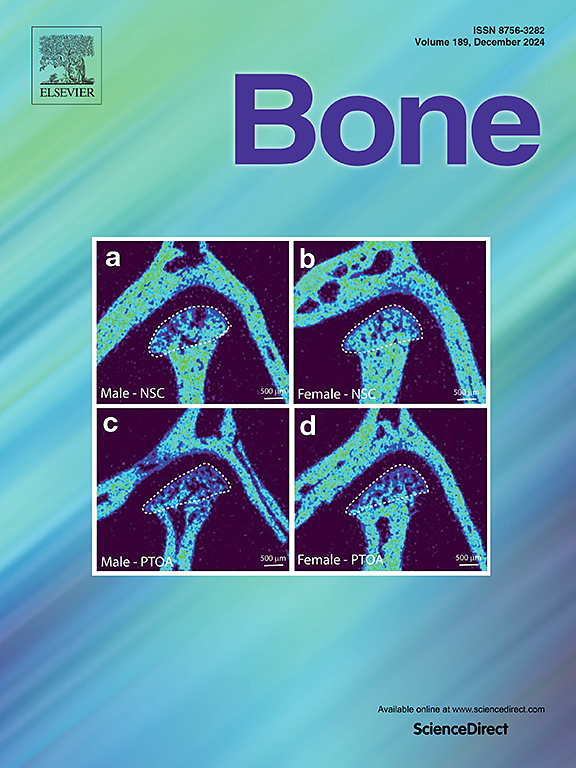Effects of dopaminergic neuron degeneration on osteocyte apoptosis and osteogenic markers in 6-OHDA male rat model of Parkinson's disease
IF 3.5
2区 医学
Q2 ENDOCRINOLOGY & METABOLISM
引用次数: 0
Abstract
Parkinson's disease (PD) and osteoporosis are prevalent chronic conditions that impact a significant proportion of the aging population. Observational and longitudinal studies consistently demonstrate that individuals with PD face an elevated risk of osteoporosis and reduced bone mineral density compared to control groups. However, there is currently no experimental evidence demonstrating the impact of dopaminergic neuron degeneration on bone metabolism. In the present study, we used a male rat model of PD induced by unilateral injection of 6-hydroxydopamine (6-OHDA) in the left medial forebrain bundle (MFB) to evaluate the effect of dopaminergic neuron lesion on certain parameters of bone metabolism. To confirm the dopaminergic neuron lesion, cylinder and Rotarod tests were applied to rats injected with 6-OHDA or vehicle. Osteocyte density and viability were determined through histology and TUNEL assay. Western Blot and immunohistochemistry analysis were performed to investigate whether dopaminergic degeneration influences the expression of some apoptotic markers (Caspase 3 and Cytochrome C) and some osteogenic markers (ALP, OCN, and RUNX2). Our findings show that the dopaminergic lesion resulting from the injection of 6-OHDA was successfully confirmed through behavioral tests. Furthermore, the degeneration of dopaminergic neurons induced by 6-OHDA leads to apoptosis of osteocytes associated with a significant reduction in the tissue expression of the studied osteogenic markers. Thus, our study provides evidence that 6-OHDA-induced degeneration of dopaminergic neurons leads to osteocyte apoptosis, which may contribute to the development of some signs of osteoporosis.
多巴胺能神经元变性对 6-OHDA 雄性帕金森病大鼠骨细胞凋亡和成骨标志物的影响
帕金森病(Parkinson's disease,PD)和骨质疏松症是普遍存在的慢性疾病,影响着很大一部分老龄人口。观察性和纵向研究一致表明,与对照组相比,帕金森病患者面临骨质疏松症和骨矿物质密度降低的风险更高。然而,目前还没有实验证据证明多巴胺能神经元变性对骨代谢的影响。在本研究中,我们利用雄性大鼠左侧前脑内侧束单侧注射6-羟基多巴胺(6-OHDA)诱导的帕金森病模型,评估多巴胺能神经元病变对骨代谢某些参数的影响。为证实多巴胺能神经元损伤,对注射了6-OHDA或药物的大鼠进行了圆柱体和旋转体试验。通过组织学和 TUNEL 检测确定骨细胞密度和存活率。通过Western印迹和免疫组化分析,研究多巴胺能变性是否会影响一些凋亡标志物(Caspase 3和细胞色素C)和一些成骨标志物(ALP、OCN和RUNX2)的表达。我们的研究结果表明,注射6-OHDA导致的多巴胺能损伤已通过行为测试得到证实。此外,6-OHDA 诱导的多巴胺能神经元变性会导致骨细胞凋亡,与此同时,所研究的成骨标志物的组织表达也会显著减少。因此,我们的研究提供的证据表明,6-OHDA诱导的多巴胺能神经元变性会导致骨细胞凋亡,这可能会导致骨质疏松症的某些症状的发生。
本文章由计算机程序翻译,如有差异,请以英文原文为准。
求助全文
约1分钟内获得全文
求助全文
来源期刊

Bone
医学-内分泌学与代谢
CiteScore
8.90
自引率
4.90%
发文量
264
审稿时长
30 days
期刊介绍:
BONE is an interdisciplinary forum for the rapid publication of original articles and reviews on basic, translational, and clinical aspects of bone and mineral metabolism. The Journal also encourages submissions related to interactions of bone with other organ systems, including cartilage, endocrine, muscle, fat, neural, vascular, gastrointestinal, hematopoietic, and immune systems. Particular attention is placed on the application of experimental studies to clinical practice.
 求助内容:
求助内容: 应助结果提醒方式:
应助结果提醒方式:


